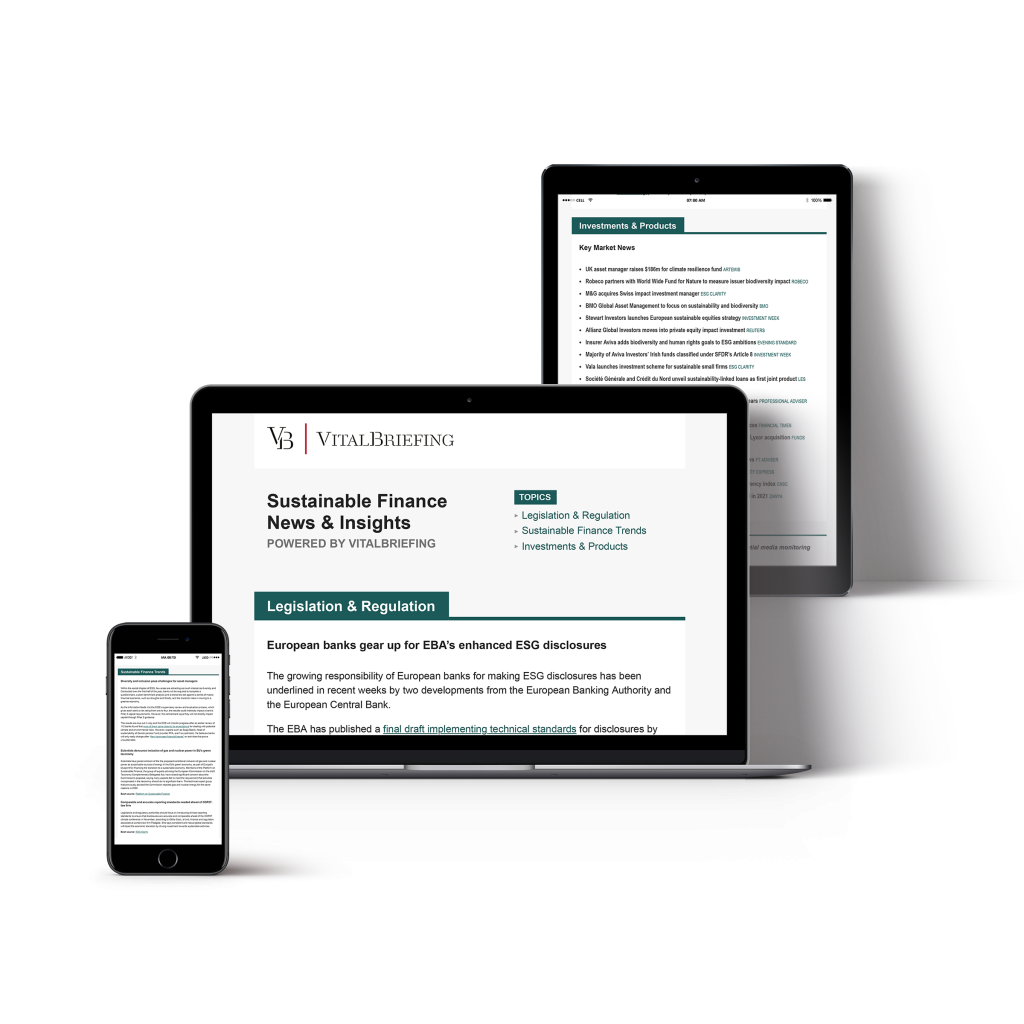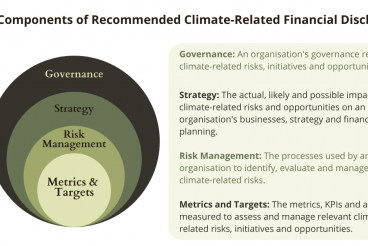
How can an organisation really commit to sustainability — and will doing so bring actual ROI? How can business leaders ensure they’re not simply greenwashing? In the flood of information and content about sustainability, sustainable finance and sustainable business practices, we’re finding too few answers to these and other ever-more-pressing questions.
That’s why we’ve asked one of our resident sustainability and communications experts – VitalBriefing International Advisory Board member Sophie Öberg – to clear up the confusion. Sophie is Deputy Director of Inspiring More Sustainability Luxembourg (IMS), the country’s leading network for corporate responsibility, and co-chairs the Sustainability Strategy for Boards committee at the Luxembourg Association of Independent Directors.
In this second of two parts — read Part 1 here — Sophie examines the definition of ‘sustainability’, offers history and context and identifies local and global players she admires for their circularity and commitment to transformational strategies.
What does it take to create the kind of culture change necessary to become a ‘sustainable’ organisation? How should a company or agency begin, execute and announce its effort?
An organisation committed to transitioning towards becoming a ‘sustainable organisation’ shouldn’t worry too much about making promises and announcements. Rather, it should focus first on its people.
Although it’s important to keep in mind that there is no ‘one size fits all’ solution to making that change, best practices show that the following factors often play a key role:

- A top-down approach: This means the leadership mindset must decisively reflect a dedication to sustainability. It’s absolutely necessary that those at the top show a clear conviction that this is the way forward – that clear devotion has a critical impact, helping the rest of the staff see this initiative is not separate from the business but, rather, that it’s integrated. It’s a long-term commitment for a company or organisation to become sustainable, and leadership’s duty to make that clear. Leaders should ‘connect the dots’ for their colleagues, showing them how the culture change connects to becoming sustainable.
- A bottom-up approach: The more an organisation champions its own people, the better. Everyone should feel essential, and should understand the role they play in making a difference. It must be clear to them what the challenges are, and how they’re interconnected and interdependent. The organisation’s sustainability successes should be celebrated; the whole staff should feel a sense of responsibility and ownership in the transition.
Many reading this article may now be asking, “how does a company or organisation turn its words and intentions into actionable steps forward?” That’s a fair question – after all, getting the leadership and staff on board is just a (crucial) first step.
Sustainability is about moving from an ‘inside-out’ to an ‘outside-in’ perspective, listening to and taking into account the experiences and viewpoints of every stakeholder.
A good starting point is to undergo a so-called materiality assessment: an analysis that prioritises current and emerging sustainability issues (environmental, social and economic) based on the perspectives of both the organisation itself and its various stakeholders.
This assessment brings sustainability to the fore, showcasing its links to the business challenges facing the organisation.
Next comes implementation of strategy. Leading a business towards sustainability inherently requires a process of change management and continuous improvement driven both top-down and bottom-up – with transparency, concertation, consolidation and communication at the core.
Note that communication with both internal and external stakeholders is essential.
Here are some other key implementations for success according to best practices in the area:
- Establish a steering committee with top management to show ownership, give visibility and mandate.
- Create technical committees for the different areas of focus comprised of ambassadors from different departments. Those representatives help drive sustainability across the organisation.
- Identify ‘critical friends’ – or linchpins – at board level to help keep sustainability at the centre of all operations.
- Regular evaluation and revision of the strategy and benchmarks.
Is there ROI in undertaking any of these efforts, especially when an organisation has to justify the work it takes to meet the various criteria? How can and should ROI be measured?
Sadly, sustainability and profitability are still too often viewed as mutually exclusive — a real shame because doing good is actually good for business. Not to mention, as environmentalist David R. Brower succinctly puts it, “No business will be done on a dead planet.”
In fact, sustainability is an enabler of growth: Taking care of resources, being aware of interconnections and impacts, integrating long-term perspectives – these are all key elements of corporate sustainability. But they’re also good business practice.
For example, an organisation that fails to take increasing constraints on resources into its sustainable business strategy is irresponsible. Resource scarcity pressures the market, negatively impacts ecosystems and communities and leads to the destruction of the market.
Sustainable Business isn’t a beauty contest. Rather, it’s about doing the right thing for your customers and for your business. Indeed, the success of a business relies on the success of the stakeholders along its value chain – both upstream and downstream.
Success also depends on the community and the commitment of staff. When the wider community respects a company, that business inevitably grows its customer base. And when an employer is liked and valued by its staff, it gets more from them.
Ultimately, you could say that sustainable business is a way to deliver ‘purpose’ – people (i.e. staff, customers and partners) get inspired by purpose and want to be involved in the work it takes to achieve it.
To that point, in The Comprehensive Business Case for Sustainability (Harvard Business Review), the authors provide examples showing how sustainability benefits the bottom line. They conclude that “companies that proactively make sustainability core to business strategy will drive innovation and engender enthusiasm and loyalty from employees, customers, suppliers, communities and investors.”
Which brings me to this: valuation is pivotal to the sustainability transition we’re discussing.
As we all know, that which is valued receives attention, protection and investment. Therefore, valuation methods need to be redefined for unpriced costs and benefits, and both the natural and human capital themselves need to be valued, as advocated by the triple capital accounting framework.
The good news is that current ROI tools and methods are being reviewed and updated to better reflect that still-unmeasured value. However, challenges exist, inhibiting this framework from simply being put into practice — such as the collection of, and access to, valuable and comparable data, the intangibility of returns, and the longer-term payback window.

One executive at a large financial institution told us her CEO asked her for a communications plan around their sustainable business practices – but this would result in greenwashing. Rather, she argued that the entire organisation needed a top-to-bottom re-evaluation – a concerted and committed drive to put in place a real transformation. How common is this kind of situation?
This is a significant challenge that many have faced in recent years. Sustainability is receiving more and more attention and, consequently, it is now crucial for an organisation to ‘join the conversation’ – for business, recruitment and reputation, among other benefits.
On the flip side, though, many organisations fail to back those words with real actions. Those that don’t go further than being part of the conversation – that don’t activate actual sustainable business practices – are indeed greenwashing their activities.
Let me be clear: a communications plan focused around an organisation’s sustainability-related efforts isn’t necessarily greenwashing – as long as the organisation in question is being truthful and actually running its business in a sustainable way, even if it is doing so neither perfectly nor comprehensively (yet).
There are three key notions a sustainable business must cover in its public disclosures: progress/improvement, change and transparency. If the communications plan covers these elements, an organisation increases its chances of avoiding greenwashing.
That level of communication, as mentioned already, helps activate an organisation’s sustainability goals through stakeholder engagement – as well as in the change management process and its continuous improvement.
We often hear that despite all these initiatives, commitments, certifications, guidelines, regulations and new sustainable business models we won’t be able to achieve our goals if we do not in parallel change our basic values. Do you agree?
Definitely.
While all these initiatives, commitments, new models, certifications, guidelines and regulations (as you have listed them) are critical in supporting and guiding us to become more sustainability-oriented, a change of values – and mindset – are needed at the core.
This concept actually ties back to the first question you asked me in Part 1 of this Q&A — specifically to the definition of sustainability. As I explained, driving a business sustainably requires us to bring sustainability-centred values to the fore that haven’t actually been given much priority in past decades: People, Planet and Prosperity.
It’s a question of recognising that we are all part of one system, that we are interdependent on each other; the growth and well-being of one is connected to the growth and well-being of the others – regardless of one’s nature.
— — —

Do you need to stay on top of ESG and sustainable finance news? Check out the Sustainable Finance News & Insights Briefing, bringing you news summaries and market analysis on regulation, legislation, investment trends, products and more.
Produced by expert financial journalists, it cuts through the confusion, saving you time by delivering everything you need to know in one monthly newsletter.





